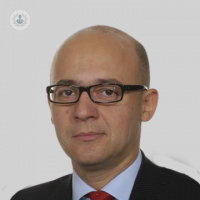Voice changes after thyroid surgery: will the voice return to normal?
Autore:After undergoing surgery on the thyroid, it’s quite possible to have a change in how your voice sounds. There are various reasons for this which Mr Radu Mihai will thoroughly explain along with how the voice can change and whether or not these voice changes are permanent. As a leading consultant general and endocrine surgeon, Mr Mihai is highly skilled in the matter – read on to learn from a specialist about all there is to know about voice changes after thyroid surgery.

What makes a person’s voice?
A person’s voice is a very personal attribute that is dependent on signals from specialised areas of the brain and a coordinated movement of laryngeal muscles. In the middle of the larynx (voice box), the movement of two vocal cords creates the vibrations of the air that resonates through the upper airways and leads to the sounds of the voice. Each vocal cord is under the control of two nerves – the recurrent laryngeal nerve (controls the movements of the vocal cord) and the superior laryngeal nerve (controls the tension in the vocal cord hence it allows for high pitched voice). Both nerves are in close contact with the thyroid gland and therefore, during the operation to remove the thyroid gland, the nerves are at risk of injury.
What causes voice changes after thyroid surgery?
The nerves can be injured by mechanical factors (e.g. compression, stretching) or by the heat created by instruments used to seal blood vessels. Mild/limited injury leads to a temporary blockage of nerve conduction/function that generally recovers completely and spontaneous after six to eight weeks. More severe trauma to the nerve or complete transection (cutting) of the nerve leads to permanent interruption of its function and therefore, a paralysed vocal cord.
Unfortunately, the voice can also be altered even in the absence of any nerve injury. This topic remains little explored and insufficiently understood. Local haematoma (bleeding outside the blood vessels) and/or oedema (i.e. swelling) of the muscles are possible causes.
What type of voice changes might I expect after thyroid surgery?
If the vocal cord is paralysed, there is a coarse change to the character of the voice which can be described as hoarseness. Some patients experience such changes before surgery and this is a worrisome sign because it suggests that the recurrent laryngeal nerve is compressed/invaded by an aggressive thyroid cancer or that the nerve is severely stretched by a very large goitre.
Injury to the superior laryngeal nerve leads to a loss of projection (i.e. inability to raise the voice over a noisy background), loss of high pitch of the singing voice and inability to sing in falsetto (as the famous Bee Gees brothers used to do).
More subtle changes in voice can be demonstrated using professional recording equipment but such changes remain undetected by patients and clinicians and are of doubtful social, professional or personal implications.
In the absence of any nerve injury, patients with intact vocal fold motility might still experience voice fatigue during phonation (producing speech sounds), difficulties with high pitch voice and a more monotone pitch that can be more than two semitones lower.
How common is to experience voice problems after thyroid surgery?
There is an inconsistency between the reported risk of injury to the nerves and the frequency (incidence) of voice changes.
In several large studies of patients without nerve injury (i.e. whose vocal cords were moving normally), subjective voice complains occurred in 30-80% of patients. Though most agree that the voice changes normalise progressively over within 3-6 months postoperatively, such encouraging data has to be balanced by reports that subtle voice changes persisted up to 6 months in 90% of patients, mostly through voice fatigue, changes in pitch, voice alterations when speaking loudly or singing.
The risk of injury to the recurrent laryngeal nerve ‘in experienced hands’ used to be quoted to be <1%. Data provided by national audits maintained by profession bodies are more likely to reflect reality. For example, the audit maintained by the British Association of Endocrine and Thyroid Surgeons reported on a total of over 10000 thyroid operations with an overall 2.5% rate of recurrent laryngeal nerve palsy and 5% incidence of voice changes. Such data are derived from the self-reported cases operated on by a group of enthusiasts and as such might be too optimistic to be concluded to the overall practice of thyroid surgery across the country.
Currently, I’m running a national study with contribution from colleagues in several large hospitals asking patients to complete a questionnaire that describes their voice and swallowing before and after thyroid surgery (for more information visit thyvoice.org). It is expected that this study should give a more accurate description of the incidence and the severity of voice symptoms and will demonstrate how common and how fast these symptoms can settle.
Will my voice ever return to normal?
As mentioned above, if there is no nerve injury or if the injury is minimal, it’s expected that voice changes will settle within three to six months. If one nerve is transected (i.e. cut), there is no possibility of a complete return to normal voice.
|
Generic advice |
Voice advice |
|
• Don’t smoke • Keep a supply of drinking water handy • Humidify the environment • Eliminate habitual throat clearing • Avoid all non-speech voice use (throat clearing, coughing, “voiced” sneezing, crying, “voiced” laughing and odd sound-effects) |
• Minimize voice use: – Be brief when talking – Avoid any loud use of voice – Keep phone calls brief • Speak more slowly, articulate clearly • Speak at a comfortable pitch and loudness level • Balance extra vocal demands with vocal rest |
What should I do if my voice doesn't return to normal?
One option is to wait up to three months with the expectation that your voice will normalise. This decision should be discussed with your surgeon who can comment on the visual integrity of the nerve and any information provided by the readings from the intraoperative nerve monitoring (if this was used).
Patients with severe voice changes, with or without associated swallowing difficulties, can be offered voice therapy. Such specialised service is not widely available so access to it might be difficult, but your surgeon can facilitate a referral.
After a full assessment of vocal cord movements using laryngoscopy (i.e. a small camera passed through the nose down to the level of the voice box to inspect the movement and position of the vocal cords), the voice is subjectively rated using the GRBAS scale based on four parameters:
- Roughness
- Breathiness
- Weakness (asthenia)
- Strain
These are measured on a four-point scale ranging from 0 (normal) to 3 (severely abnormal). Most likely, patients will also fill a questionnaire to quantify their own perception of the voice and the impact of voice changes on daily life (Voice Handicap Index questionnaire ). These ‘scores’ will allow an objective assessment of any future improvements after therapy. Based on the problems experienced when first referred for voice therapy, a set of exercises are provided with the aim of compensating for the deficit induced by the nerve injury. Such exercises might include head-neck-shoulders relaxation, abdominal breathing, appropriate tone focus, lip and tongue trills.
For patients with persistent/established vocal cord palsy at 6-12 months after thyroid surgery, an expert laryngology consultant can advise whether injection into the vocal cord or another operation (medialisation thyroplasty) could be beneficial.
As an experimental procedure, some proposed reinnervation (restoring nerve supply) of the laryngeal muscles through an operation that tries to join (suture) the divided laryngeal nerve with another functional nerve in the vicinity of the voice box. This has not been confirmed yet as a routine treatment.
Can these problems be avoided?
The risk of voice changes after thyroid surgery cannot be eliminated but can be mitigated/alleviated. The following can all contribute towards minimising the incidence of nerve injury and subsequent voice changes:
- If the operation performed by a surgeon with a high volume of thyroid surgery (more than 20-50 cases per year)
- If there is meticulous attention to the identification and protection of the two nerves that control the movement of the vocal cord
- If there is the use of nerve monitor during the operation and formal assessment of vocal cord movements before and after the operation using laryngoscopy
The risks will be discussed by your surgeon in the context of your personal medical circumstances and balanced against the need for the operation, the potential non-operative treatments available and your professional usage of the voice.
Mr Radu Mihai is an expert consultant endocrine surgeon with advanced knowledge and skill in treating the thyroid. Learn more and get in touch – visit Mr Mihai’s Top Doctors profile.


